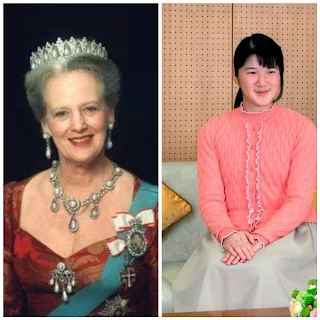Princess Aiko of Japan and Queen Margrethe II of Denmark shared the same fate. They were born in a constitutional monarchy that prohibits females from succeeding to the throne. Both are the eldest daughter of a ruling sovereign. But one can learn from the fate of another to inspire a change of destiny.
Princess Aiko, the Princess Toshi
Born on December 1, 2003, Aiko (which means a person who loves others in Japanese) came into the world eight years after the marriage of her parents, Crown Prince Naruhito and Crown Princess Masako. And three years after the Crown Princess suffered a miscarriage.
By then, Crown Princess Masako, a Harvard graduate, and a budding Japanese diplomat lived under pressure to produce a son. The Imperial Household of Japan still follows the ancient Agnatic Law of Succession where females are barred from inheriting the throne.
When the child became a girl, Crown Princess Masako sunk into depression and she ultimately withdrew from public duty and lived remotely behind the palace walls. The Imperial Household Agency stated that the Crown Princess suffered from "Adjustment Disorder", a type of mental disorder rooted in her inability to cope up with the royal life.
Her Imperial Highness, The Princess Toshi
When the child became a girl, Crown Princess Masako sunk into depression and she ultimately withdrew from public duty and lived remotely behind the palace walls. The Imperial Household Agency stated that the Crown Princess suffered from "Adjustment Disorder", a type of mental disorder rooted in her inability to cope up with the royal life.
Princess Aiko is currently not in line to succeed her father on the throne
The crown princess did not become pregnant after the birth of Princess Aiko, thus, in 2005, the Japanese parliament started discussing the possibility of changing the law of succession from agnatic primogeniture to male-preference primogeniture to allow Princess Aiko to succeed her father.
But on the following year, Naruhito's sister-in-law, Princess Kiko, the wife of his younger brother and heir-presumptive, Prince Fumihito, gave birth to a son. This circumstance halted the debate on changing the imperial household law of succession and ultimately lost the chance of granting Princess Aiko the right to succeed her father.
The Japanese imperial family
Empress Masako, Emperor Naruhito and Princess Aiko
Princess Aiko, whose sad circumstances of being born a female deprived her of mounting the Japanese throne someday, remained ineligible to take the Japanese imperial crown from her father. And when she will get married someday to a commoner, she will be forced to give up her princess title and leave the imperial family.
The future of the Chrysanthemum throne now lies in the bloodline of the Crown Prince, Fumihito, Prince Akishino. His successor is his only son, Prince Hisahito. The situation triggers a succession crisis in the Japanese imperial throne since Hisahito is only a teenager, and the next in line is the 83-year-old paternal uncle of Emperor Naruhito, Masahito, Prince Hisahito, whose marriage is childless.
On October 22, 2019, Emperor Naruhito was formally enthroned as Japan's 126th emperor in an unbroken line of succession since the 12th century. Beside him in the ceremony was his wife, Empress Masako, brother, Prince Fumihito, and sister-in-law, Princess Kiko. Nowhere to be seen in the official ceremonial portraits is his only child, Princess Aiko, because she is not in line to succeed to the throne.
Queen Margrethe II of Denmark
Just like Princess Aiko, Margrethe, who was born on April 16, 1940, during the reign of her grandfather, King Christian X of Denmark, was not destined to become Denmark's female monarch. The country maintained Salic Law or agnatic primogeniture succession which prohibits a female nor its descendants from mounting the Danish throne.
Margrethe's father, Crown Prince Frederik, has a younger brother, Prince Knud, who would be his successor under the Danish law of succession. On April 20, 1947, Frederik succeeded his father, Christian X, on the Danish throne and his younger brother, Prince Knud, became his heir-presumptive.
Emperor Naruhito during his enthronement ceremony: October 22.
Behind him is his wife, Empress Masako, followed by his heir-presumptive, Prince Fumihito
and wife Princess Kiko
and wife Princess Kiko
The future of the Chrysanthemum throne now lies in the bloodline of the Crown Prince, Fumihito, Prince Akishino. His successor is his only son, Prince Hisahito. The situation triggers a succession crisis in the Japanese imperial throne since Hisahito is only a teenager, and the next in line is the 83-year-old paternal uncle of Emperor Naruhito, Masahito, Prince Hisahito, whose marriage is childless.
On October 22, 2019, Emperor Naruhito was formally enthroned as Japan's 126th emperor in an unbroken line of succession since the 12th century. Beside him in the ceremony was his wife, Empress Masako, brother, Prince Fumihito, and sister-in-law, Princess Kiko. Nowhere to be seen in the official ceremonial portraits is his only child, Princess Aiko, because she is not in line to succeed to the throne.
Queen Margrethe II of Denmark
Just like Princess Aiko, Margrethe, who was born on April 16, 1940, during the reign of her grandfather, King Christian X of Denmark, was not destined to become Denmark's female monarch. The country maintained Salic Law or agnatic primogeniture succession which prohibits a female nor its descendants from mounting the Danish throne.
Her Majesty, Queen Margrethe II of Denmark
Margrethe's father, Crown Prince Frederik, has a younger brother, Prince Knud, who would be his successor under the Danish law of succession. On April 20, 1947, Frederik succeeded his father, Christian X, on the Danish throne and his younger brother, Prince Knud, became his heir-presumptive.
King Frederik IX and his wife, Queen Ingrid (born Princess Ingrid of Sweden) had three children but all females - Princess Margrethe, Princess Benedikte, and Princess Anne-Marie. The latter married her second cousin, King Constantine II of Greece in 1964.
The line of succession to the Danish throne seemed assured on the blood line of Prince Knud. He married his first cousin, Princess Caroline-Mathilde, and had three children: Princess Elisabeth, Prince Ingolf and Prince Christian.
However, in 1953 when Princess Margrethe was 13 years old, the course of her destiny began to change. The Danish parliament passed the Danish Act of Succession of 1953 altering the succession law to male-preference primogeniture law.
Queen Margrethe II and her husband, Prince Henrik who died in 2018 from a lingering illness
The line of succession to the Danish throne seemed assured on the blood line of Prince Knud. He married his first cousin, Princess Caroline-Mathilde, and had three children: Princess Elisabeth, Prince Ingolf and Prince Christian.
Margrethe II's successor, Crown Prince Frederick with his wife, Crown Princess Mary
However, in 1953 when Princess Margrethe was 13 years old, the course of her destiny began to change. The Danish parliament passed the Danish Act of Succession of 1953 altering the succession law to male-preference primogeniture law.
This succession law has been the norm in most European kingdoms during that time. Following the passage of this law, Princess Margrethe became her father's heir-presumptive replacing her uncle.
In 1972, King Frederik IX died and Margrethe ascended the Danish throne as Queen Margrethe II and continue to reign until now. She and her husband, Prince Henrik, have two sons: Crown Prince Frederik and Prince Joachim.
Welcome to the modern world, Japan
Drawing from this inspiration, Japan may learn lessons from the modern world of royalty and may influence to change its Act of Succession to embrace the call of times.
In 1972, King Frederik IX died and Margrethe ascended the Danish throne as Queen Margrethe II and continue to reign until now. She and her husband, Prince Henrik, have two sons: Crown Prince Frederik and Prince Joachim.
Welcome to the modern world, Japan
Drawing from this inspiration, Japan may learn lessons from the modern world of royalty and may influence to change its Act of Succession to embrace the call of times.
Aiko, Princess Toshi
This is to allow Princess Aiko, just like Queen Margrethe II, to succeed, instead of her uncle. Japan has been one of the world's leaders in innovation and modernity, it's crazy to think that their succession law is still horribly ancient and still discriminates women from holding power.
Japan's view toward the monarchy is still very patrilineal, which contradicts the concept of gender equality. We're hoping one day, Japan will change its succession law and recognize the capability of women to become sovereign.




















0 Comments